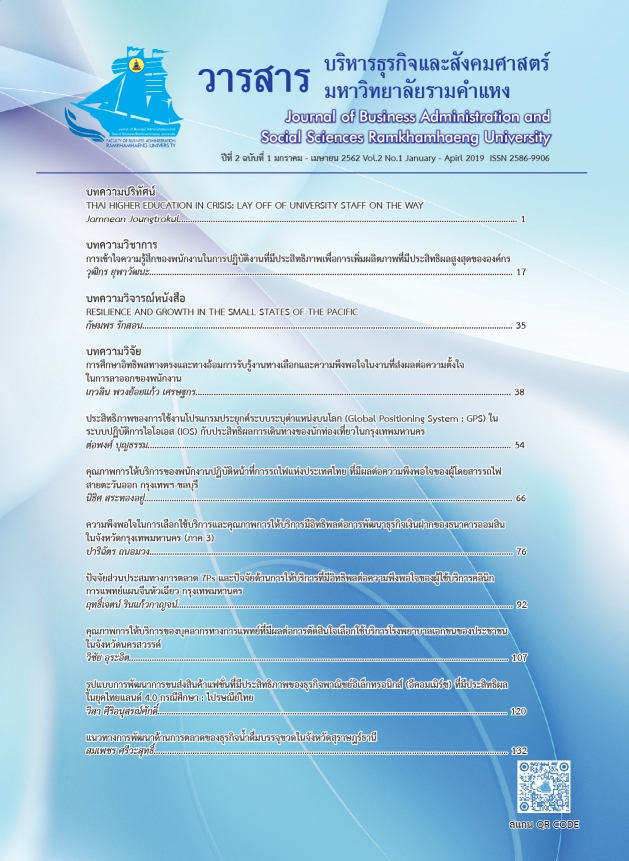DEVELOPMENT GUIDELINES FOR MARKETING OF BOTTLED WATER BUSINESS IN SURAT THANI PROVINCE
Main Article Content
Abstract
This research study focused on six issues: (1) decision making behavior; (2) customers’ perception level; (3) customers’ loyalty level; (4) differences of perception based on purchasing behavior; (5) relationship between perception and loyalty focusing on bottled water; and (6) guidelines for the development of the market of bottled water in Surat Thani Province. A study of consumer behavior regarding the process and the purpose of purchasing bottled water, according to S-R Theory (Kotler, 2003), explored product perception (4P) and brand loyalty (Oliver, 1999). The research methodology of this study was a combination of quantitative research and qualitative research, a mixed methods methodology. The population in the quantitative research were the consumers of bottled water in Muang Surat Thani. A sample of 400 consumers in Surat Thani province was chosen to answer a questionnaire and eight Surat Thani bottled water producers or marketing persons were interviewed in the qualitative research. The research tools used were: 1) a bottled water consumer opinion questionnaire; and 2) an interview of the producers or marketing persons involved in the bottled water business. Data were analyzed by means of frequency, percentage, mean, standard deviation and hypotheses tested by using t-test, F-test and Pearson correlation coefficient. The qualitative analysis was carried out by content analysis. Then, the researcher summarized the content or key points, according to the research objectives. It was found that most of the respondents bought the Ratchapruksa drinking water brand, packaged in 600-950 ml. clear plastic bottles from service cars, because it was easier to buy this brand than other brands. The frequency of buying bottled water was approximately 1-2 time/month and the average cost was around 101-200 bahts/time. The overall perception level was at a high level. The highest level was quality and perception, while brand, design, package and service were at a high level and image was at a moderate level. Additionally, the overall customer loyalty and each factor were at a high level, consisting of intention to buy, convince of brand attitude, behavior and brand loyalty, respectively. It was found that, for respondents who bought different brands from different sellers, reasons and frequencies had significantly different loyalty levels. The relationship test found that customer perception and brand loyalty had a moderately positive relationship (r = .41), which was statistically significant at the .01 level. The in-depth interview results found that drinking water entrepreneurs and marketing stakeholders should improve the quality of their product, according to a high standard, as well as emphasizing choosing appropriate plastic bottles and containers. Furthermore, drinking water managers should avoid applying price competition. In the case of distribution channel, marketing managers should focus on increasing the frequency of delivery, number of distributors and online channels, because of convenience and low cost. Finally, marketing promotion should apply stimulating sales techniques, such as discounts, redemption and trial products.
Article Details
เนื้อหาและข้อมูลในบทความที่ลงตีพิมพ์ในวารสารบริหารธุรกิจและสังคมศาสตร์ มหาวิทยาลัยรามคำแหง ถือเป็นข้อคิดเห็นและความรับผิดชอบของผู้เขียนบทความโดยตรง ซึ่งกองบรรณาธิการไม่จำเป็นต้องเห็นด้วย หรือร่วมรับผิดชอบใดๆ
บทความ ข้อมูล เนื้อหา รูปภาพ ฯลฯ ที่ได้รับการตีพิมพ์ในวารสารบริหารธุรกิจและสังคมศาสตร์ มหาวิทยาลัยรามคำแหง ถือเป็นลิขสิทธิ์ของวารสารบริหารธุรกิจและสังคมศาสตร์ มหาวิทยาลัยรามคำแหง หากบุคคลหรือหน่วยงานใดต้องการนำบทความทั้งหมดหรือส่วนหนึ่งส่วนใดไปเผยแพร่ต่อ หรือเพื่อกระทำการใดๆ จะต้องได้รับอนุญาตเป็นลายลักษณ์อักษรจากวารสารบริหารธุรกิจและสังคมศาสตร์ มหาวิทยาลัยรามคำแหง ก่อนเท่านั้น
References
จาริณีย์ เจริญไทยทิพย์. (2554). การเปรียบเทียบความพึงพอใจที่มีอิทธิพลต่อความภักดีในการบริโภคน้ำดื่มบรรจุขวดและน้ำแร่บรรจุขวดของผู้บริโภคในกรุงเทพมหานคร. วิทยานิพนธ์บริหารธุรกิจมหาบัณฑิต, มหาวิทยาลัยศรีนครินทรวิโรฒ.
ดิฐวัฒน์ ธิปัตดี. (2551). ปัจจัยที่มีอิทธิพลต่อความจงรักภักดีในตราสินค้าน้ำดื่มบรรจุขวดตราสิงห์ของผู้บริโภคในกรุงเทพมหานคร. วิทยานิพนธ์บริหารธุรกิจมหาบัณฑิต, มหาวิทยาลัยศรีนครินทรวิโรฒ.
พรชัย ไชยเสนีย์. (2557). กลยุทธ์การออกแบบตราสินค้าและบรรจุภัณฑ์นํ้าดื่มในยุคเศรษฐกิจชีวภาพ. วารสารวิชาการ คณะสถาปัตยกรรมศาสตร์ สถาบันเทคโนโลยีพระจอมเกล้าเจ้าคุณทหารลาดกระบัง, 4(2), 31-41.
สุภางค์ จันทวานิช. (2554). การวิเคราะห์ข้อมูลในการวิจัยเชิงคุณภาพ. กรุงเทพฯ: จุฬาลงกรณ์มหาวิทยาลัย.
หมะหมูด หะยีหมัด. (2555). ความภักดีต่อตราสินค้าในมิติเชิงทัศนคติและมิติเชิงพฤติกรรม. วารสารบริหารธุรกิจ คณะเศรษฐศาสตร์และการสื่อสาร มหาวิทยาลัยนเรศวร, 8(1), 67-73.
Kotler, P. (2003). Marketing Management (11th ed.). Upper Saddle River, NewJersey: Prentice –Hall
Oliver, R. L. (1999). Whence consumer loyalty. Journal of Marketing, 63(10), 33-44Yamane. (1973). Statistics: An Yamane, T. (1973). Introductory Analysis (3rd ed.). Newyork: Harper and Row Publication.
